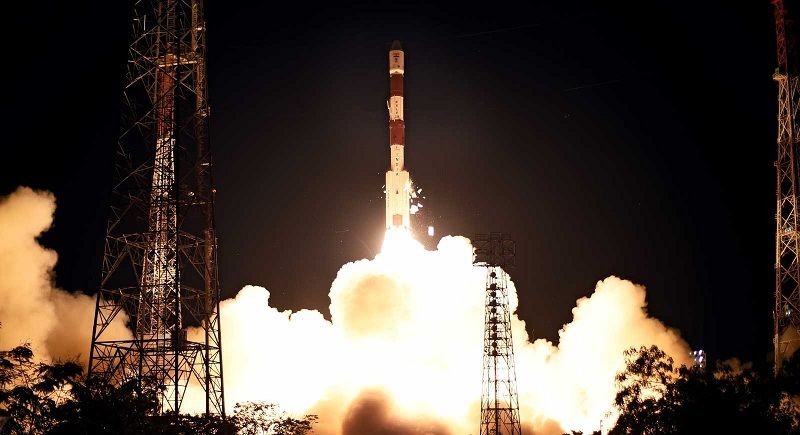In new milestone ISRO's PSLV launches satellites into 2 orbits
In its longest-ever mission spread over two hours, India's workhorse launch vehicle PSLV today successfully launched eight satellites, including the country's SCATSAT-1 and five satellites from other nations, in two different orbits to achieve another milestone. There were two Fourth Stage Engine restarts for the purpose of injecting the satellites into different orbits.

SCATSAT-1, the 371-kg primary satellite, was first injected in a 730-km Polar Sunsynchronous Orbit (SSO) after 17-odd minutes after the 44.4 metre tall PSLV-C35 lifted off at 9.12 AM from the spaceport at Sriharikota. The rocket then achieved with precision the designated task of injecting the other satellites after over two hours and 15 minutes, in a lower polar orbit of 689km. The total weight of the payloads carried by PSLV in its 15th flight in 'XL' configuration was about 675kg.
Besides SCATSAT-1, the other satellites that were injected in orbit were two Indian university satellites, PRATHAM and PISAT, three from Algeria-- ALSAT-1B, ALSAT-2B and ALSAT-1N and one each from the US and Canada--Pathfinder-1 and NLS-19, respectively.
ISRO said the SCATSAT-1 is a continuity mission for Oceansat-2 scatterometer to provide wind vector data products for weather forecasting, cyclone detection and tracking services to the users. The satellite carries Ku-band scatterometer which is similar to the one put onboard the Oceansat-2. The mission life of the satellite is five years, said ISRO.
ISRO Chairman A S Kiran Kumar congratulated the scientists and described the achievement as a landmark and said data from SCATSAT would be made available within 180 minutes.
After a long gap of almost two hours where the fourth stage has been manoeuvred, it has been restarted and the entire mission had gone on very successfully...Let me take this time to congratulate the entire ISRO team for the excellent job they have done. Today has been an indeed a landmark day for us. We have been able to achieve a launch of eight satelites, our own Scatterometer which is actually a stop-gap arrangement between Oceansat-1 and Oceansat 2. This is a satellite which is going to provide ocean wind vectors to the global community for numeric weather forecasting model. This data will be made available within 180 minutes of acquisition of data.
Vikram Sarabhai Space Centre Director, K Sivan said,
This mission is an exciting mission, an excellent mission. It is a longest mission with a lowest dispersion. We got the orbital dispersion from less than one kilometre. It is unbelievable. And all other customer satellites (three from Algeria and one each from the US and Canada) are injected precisely in the required orbit... This is the first time ISRO has established this in an orbited mission.
Commenting on future launches by ISRO, he said,
We have historic GSLV Mark III mission we are planning for year end. We also have human space programme also. Like that, exciting days are ahead.
Satish Dhawan Space Centre Director Kunhi Krishnan said, "An exciting mission has been accomplished by PSLV. Incidentally, the eighth launch of ISRO this year has delivered eight satellites into orbit."
As (VSSC Director) Dr Sivan mentioned this was the longest mission of PSLV. It is 2 hours 15 minutes but in the shortest campaign (process of integrating launch vehicle among others) in just 35 days. And this is for the first time two launches have taken place from Sriharikota in the same month. Coming days are going to be very hectic, very interesting with a variety of missions including the first developmental flight of GSLV Mark III, he said.
The two academic satellites are PRATHAM, from IIT, Bombay, and PISAT, from BES University, Bengaluru and its consortium. While PRATHAM's objective is to estimate Total Electron Count, PISAT's mission is to design and develop a nanosatellite for remote sensing applications.
Also read : ISRO to set new record by launching 68 foreign satellites by next year
Algeria's ALSAT-1B is an earth observation satellite meant for monitoring agriculture, environment and disasters, ALSAT-2B is a remote sensing satellite while ALSAT-1N is a technology demonstration satellite built for students. Pathfinder-1 from USA is a commercial high resolution imaging microsatellite while the Candadian NLS-19 (CAN X-7) is again a technology demonstration satellite built to perform experiments to help reduce space debris and for tracking commercial aircraft.








![[Funding alert] Education focused fintech startup Propelld raises $35M in Series B led by WestBridge Capital](https://images.yourstory.com/cs/2/3834ef70ca8011eba0afddaa6974ca30/Propelld-18022022-1645165203714.png)


